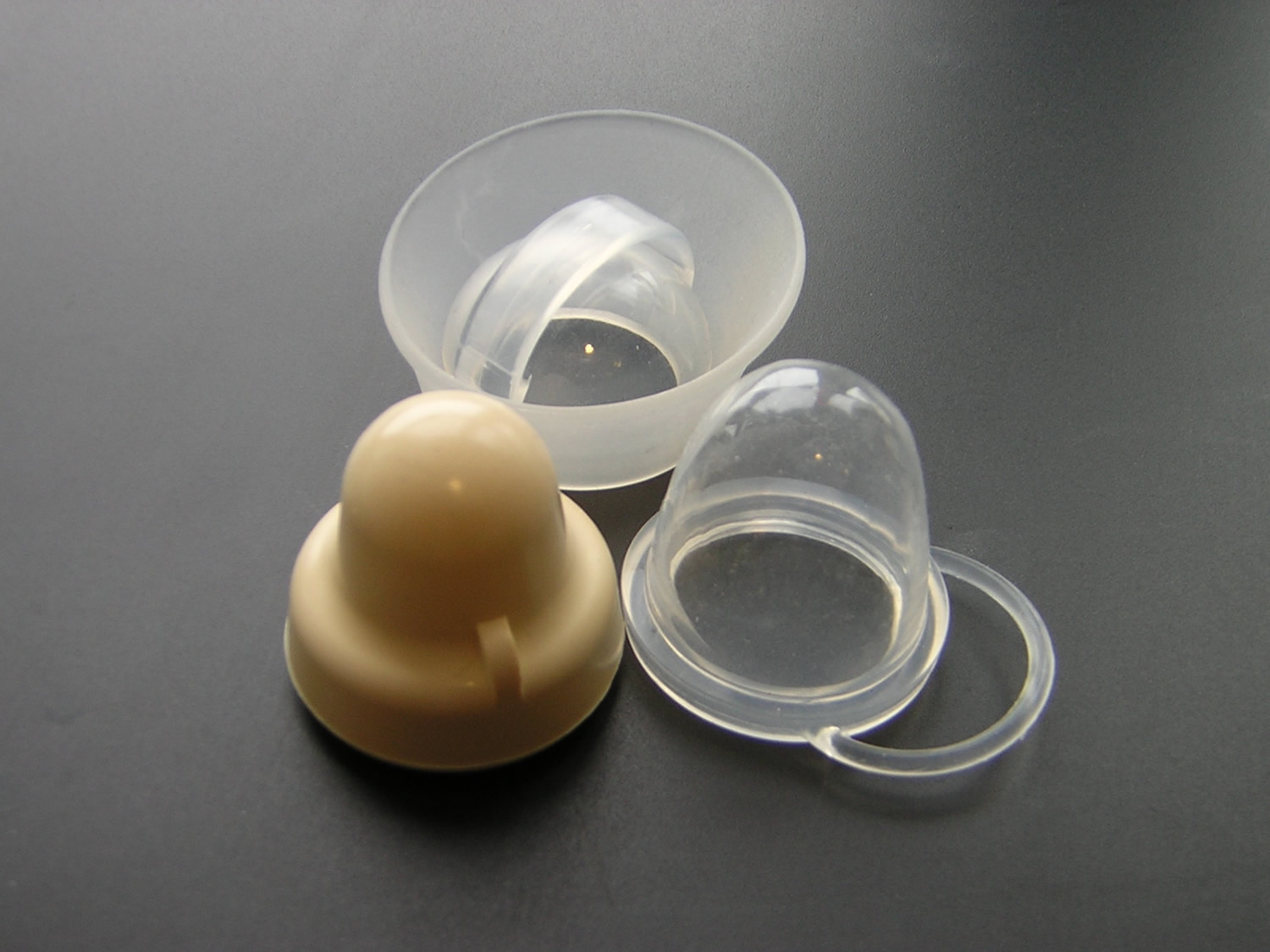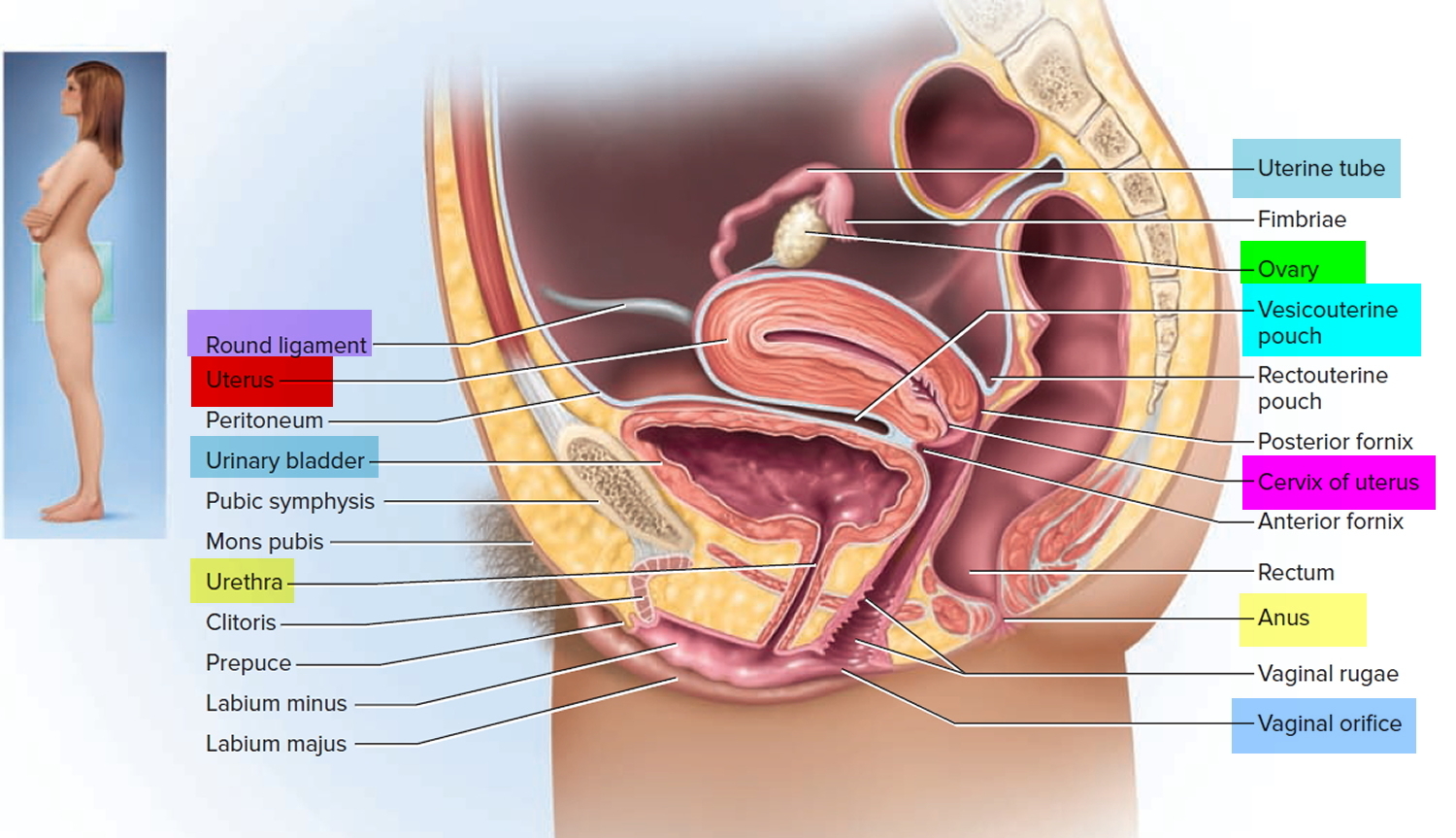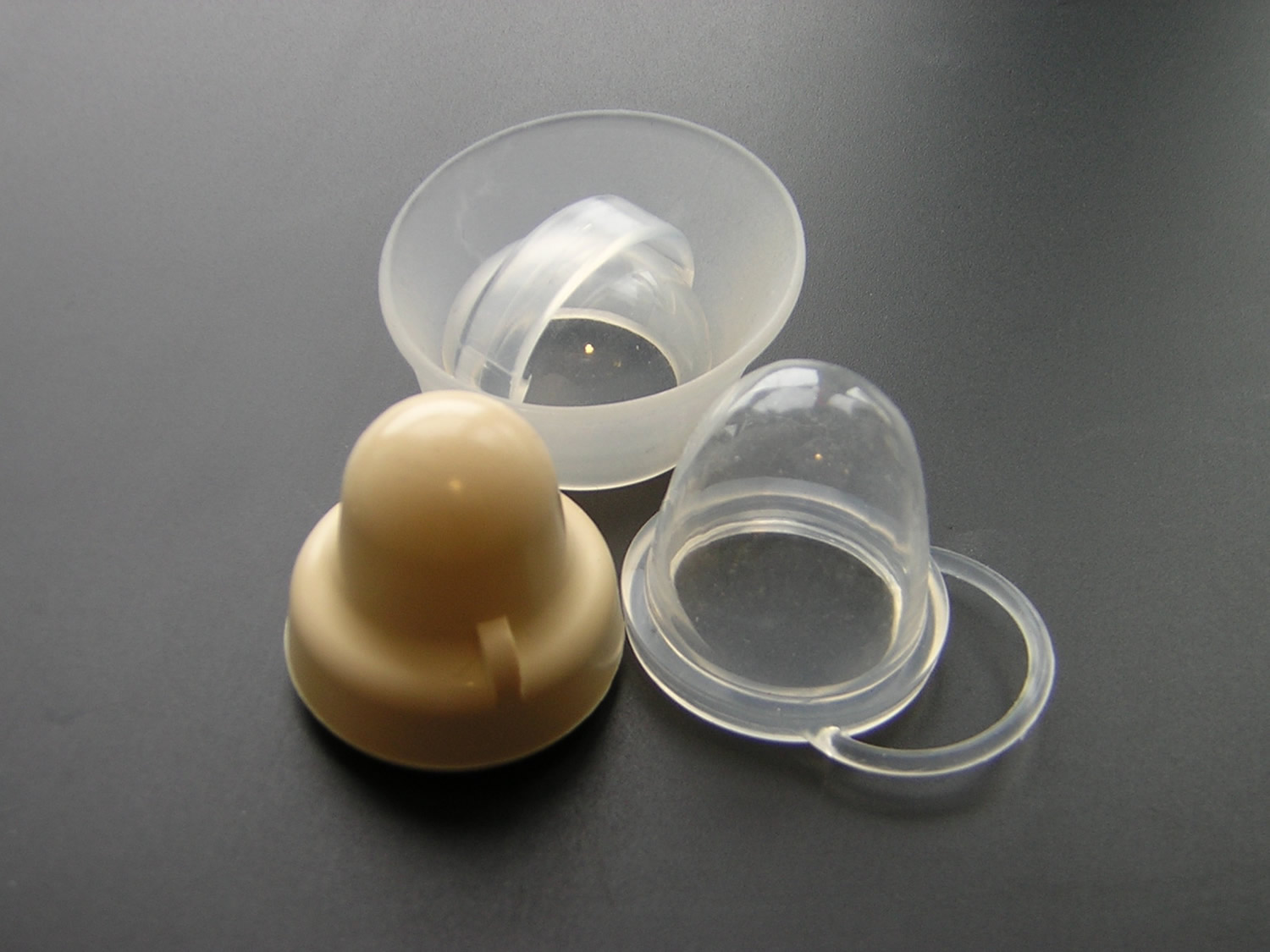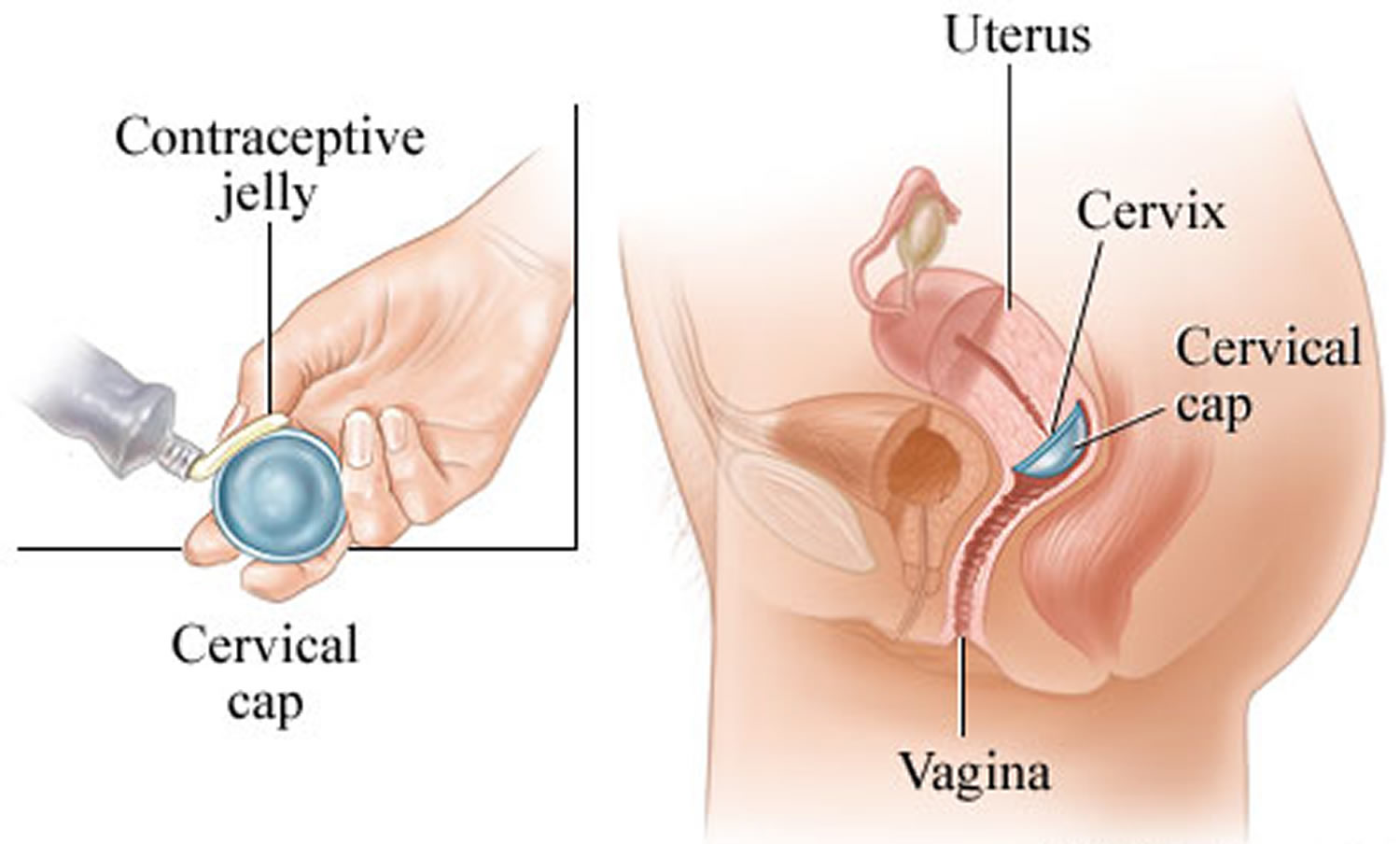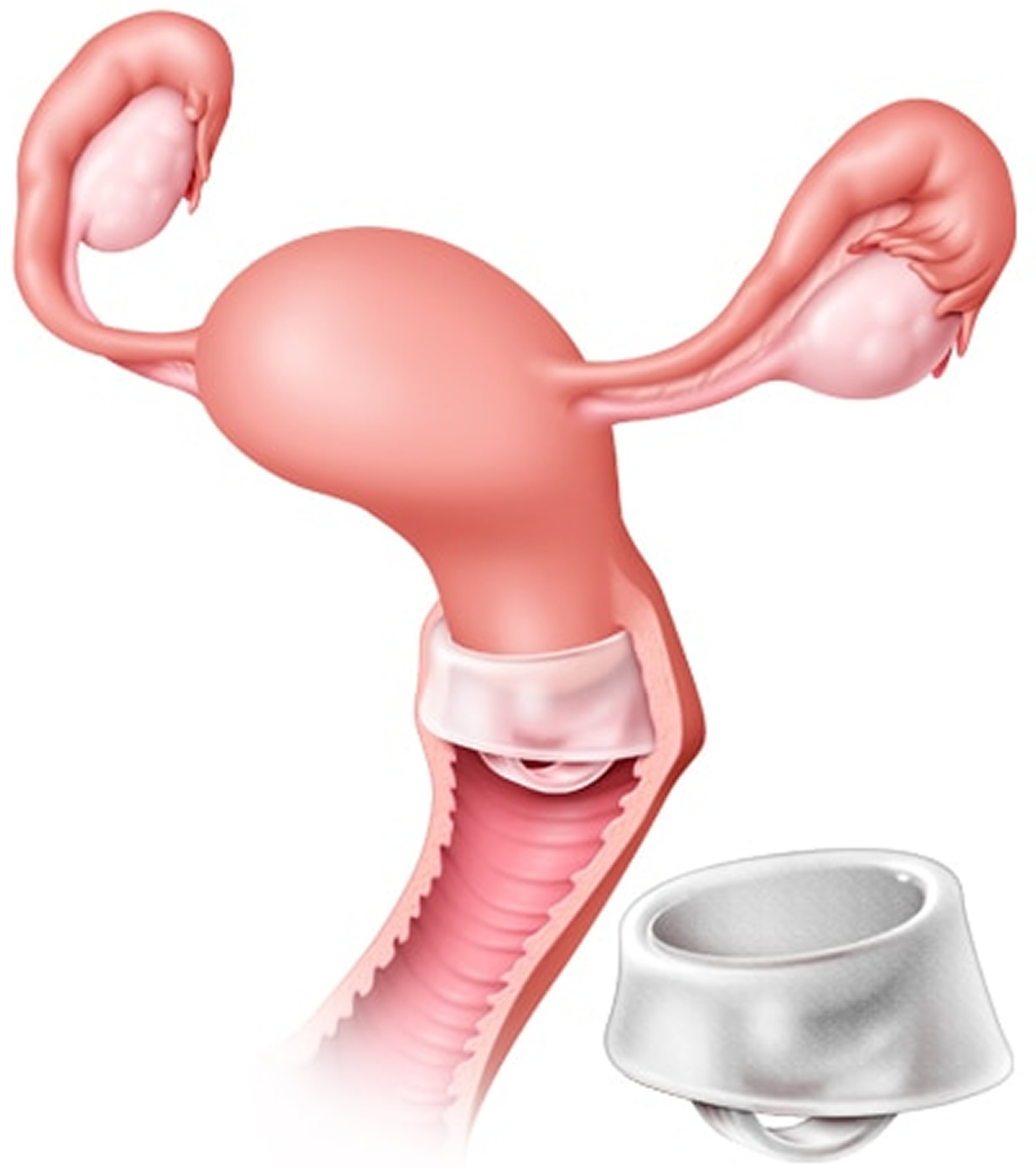Contents
What is a cervical cap
The cervical cap is a birth control (contraceptive) is a small plastic dome that fits tightly over the cervix and stays in place by suction, that prevents sperm from entering the uterus. The cervical cap is a reusable, deep silicone cup that is inserted into the vagina and fits tightly over the cervix. The cervical cap is held in place by suction and has a strap to help with removal. The cervical cap is effective at preventing pregnancy only when used with spermicide. The cervical cap does NOT protect against sexually transmitted infections (STIs), including HIV.
The cervical cap is not a method of birth control that is widely used, and very few health care providers recommend this type of contraception. If you are interested in the cervical cap, be sure to check with your health care provider to see if this method is available. Only one cervical cap — FemCap — has Food and Drug Administration (FDA) approval in the U.S. It must be fitted and prescribed by a doctor, but can be purchased online if you have a current prescription. Your doctor may ask you to come back to make sure you know how to insert the cap and use it correctly.
Refitting may be needed after having a baby or after weight gain or loss. The cervical cap is less effective in women who have given birth. You should wait 6 weeks after giving birth to use the cervical cap, until the uterus and cervix return to normal size.
The cervical cap also needs to be cared for. After each use, the cap must be washed (with mild soap and water), rinsed, and air dried, then stored in its case. Don’t put baby powder or oil-based lubricants (such as mineral oil, petroleum jelly, or baby oil)on the cap. Other vaginal creams, such as medicines for yeast infection, also can damage the cap.
The most common side effect from using a cervical cap is vaginal irritation. Some women also experience an increase in the number of bladder infections they have.
Possible risks and side effects of cervical cap:
- Because the spermicide used with the cervical cap can increase the risk of getting HIV from an infected partner, you should use the cervical cap only if you have one sexual partner and both of you are at low risk of HIV infection.
- Use of the cap may cause vaginal irritation or odor.
- To avoid an increased risk of infection and toxic shock syndrome, the cervical cap should not be used during your menstrual period.
The cervical cap should not be used by women who have:
- An abnormal shaped cervix
- A history of pelvic inflammatory disease (PID)
- Abnormal pap smears
- Severe cervicitis
- Allergy to spermicide or silicone
- Are at high risk of or have HIV/AIDS
- Are at high risk of pregnancy — you’re younger than age 30; you have sex three or more times a week; you’ve had previous contraceptive failure with vaginal barrier methods; or you’re not likely to consistently use the cervical cap
- Have vaginal or cervical abnormalities that interfere with the fit, placement or retention of the cervical cap
- Have vaginal bleeding or have a vaginal, cervical or pelvic infection
- Have a history of pelvic inflammatory disease, toxic shock syndrome, cervical cancer, third-degree uterine prolapse, uterine tract infections, or vaginal or cervical tissue tears
- Recently gave birth or had a miscarriage or an abortion
- Recently had cervical surgery
Who is a cervical cap right for?
The cervical cap is not usually recommended for most young women and teens because it can be very hard to insert correctly. Inserting and removing a cervical cap requires a girl to reach into her vagina to the cervix with her fingers. It can sometimes also be knocked out of place during intercourse, which can lead to pregnancy. The cervical cap cannot be used when a girl has her period. It is not recommended for those with some medical conditions.
Some girls prefer the diaphragm, which works like the cervical cap but is much easier to use.
What else do you need to know about cervical cap?
- Don’t use cervical cap during your period. Use another method, such as a condom, or don’t have intercourse.
- Check the cervical cap often. Get a new cervical cap if you see holes, tears, or discoloration.
- Wash the cervical cap with warm water and hand soap after removing it. Make sure it’s dry before you store it in its container. Do not use talcum or baby powder on the cap. These products may break down the silicone or irritate the vagina.
- You should be refitted for the cervical cap if you have a baby.
- The cervical cap doesn’t protect against sexually transmitted infections (STIs), such as herpes or HIV/AIDS. If you’re not sure whether your sex partner might have an STI, use a condom to protect against disease. Using a condom with the cap also protects better against pregnancy.
How much does a cervical cap cost?
There are three fees associated with the use of a cervical cap: health care provider’s visit, the cervical cap, and the spermicidal agent. Office visits to obtain a prescription for a cervical cap range from $50 to $275, the cervical cap costs between $15 and $50 dollars and spermicidal jellies, foams, or creams range from $7 to $18 dollars per package. Many health insurance plans cover these costs, and family planning clinics (such as Planned Parenthood) may charge less.
The cervical cap can last up to two years.
Where are cervical caps available?
A doctor or nurse practitioner must fit a cervical cap for you. The doctor or nurse will find the right size cap and teach you how to insert and remove it.
What about cervical caps and sexually transmitted infections (STIs)?
The cervical cap does NOT provide protection against the transmission of sexually transmitted infections. Couples having sex must always use condoms along with the cervical cap to protect against these infections.
Abstinence (not having sex) is the only method that always prevents pregnancy and sexually transmitted infections (STIs).
How does cervical cap work?
Cervical cap works by blocking most sperm from entering the uterus. Spermicide is added to the cervical cap to kill any sperm that may get outside of the protection of the cap.
The cap can be put in several hours before having sex, and must be left in at least 6 hours after sex. The cap should not stay in longer than 24 hours after sex, or for more than a total of 48 hours. While the cap is in place, its position should be checked and spermicide should be added every time a couple has sex.
The cervical cap comes in different sizes. Your health care provider will fit you for the cervical cap and demonstrate how to insert and remove the cap. He or she may confirm that the cervical cap is in the correct position by doing a pelvic exam.
Make sure you regularly check your cervical cap for wear, holes or discoloration and replace your cervical cap each year. You may need to have your cervical cap refitted after childbirth. Always use the cervical cap with spermicide. Don’t wear the cervical cap during any kind of vaginal bleeding, including your period.
Before you use the cervical cap for the first time, practice inserting the cap and checking its placement. Use a backup method of contraception, such as a male condom, the first few times you use the cervical cap.
Figure 1. Cervix position
Figure 2. Cervix location
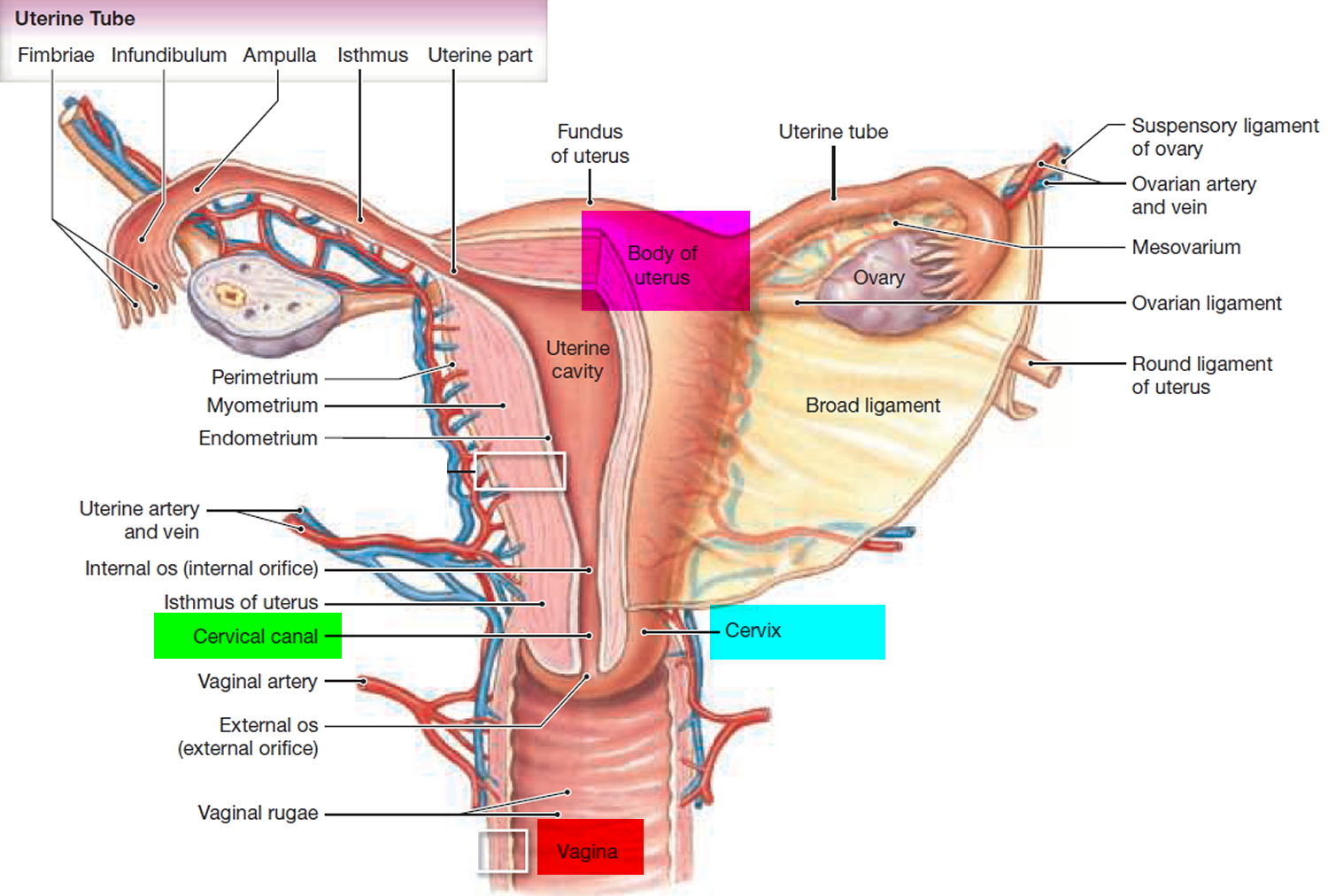
Figure 3. Cervical cap contraceptive
Figure 4. How to insert the cervical cap
Cervical cap advantages and disadvantages
The advantages of cervical cap:
- Reusable and relatively inexpensive
- Small and easy to carry
- Requires less spermicide than a diaphragm
- Rarely hinders the sexual experience
- May be used for repeated intercourse within a 48 hour period
- Allows prompt return to fertility
- Can be used while breast-feeding beginning six weeks after delivery
- It does not affect milk supply if you are breastfeeding
- Can be inserted hours before sex and remain in place for up to 48 hours
- Doesn’t require a partner’s cooperation
- Poses few if any side effects
- It has no effect on a woman’s natural hormones
The disadvantages of cervical cap:
- Requires consistent use for each sexual encounter
- Spermicide may be messy and has been linked with mucosal irritation and increased susceptibility to STIs and HIV
- A prescription is required
- May contribute towards urinary tract infections
- May cause cervical changes, such as cervicitis
- Must be cleaned and stored
- May need to be resized following a pregnancy, abortion, pelvic surgery, or weight loss or gain (20lbs or more)
- May get stuck in the cervix, requiring it to be removed by your healthcare provider
- Not as reliable as some other contraceptive methods
- Some women find them difficult to insert and therefore risk incorrect placement
- Insertion and removal may increase the risk of urinary tract infection
Refitting a cervical cap may be needed after having a baby or after weight gain or loss. The cervical cap is less effective in women who have given birth. You should wait 6 weeks after giving birth to use the cap, until the uterus and cervix return to normal size.
Cervical cap effectiveness
How well the cervical cap works depends on whether the woman uses it correctly every time. Cervical cap work fairly well if they are put in place and used correctly, but not as well as the pill, a contraceptive implant or an IUD. Typical use, which is the average way cervical caps are used, results in a failure rate of approximately 12% to 20%. This means that 12 to 20 women out of every 100 will become pregnant during the first year of use. You should take a pregnancy test if you are experiencing any pregnancy symptoms.
For women who have had a baby, the cervical cap is less effective: about 29 out of 100 of typical couples who use the cervical cap after the woman has had a baby will have an accidental pregnancy.
Table 1. Birth control methods effectiveness and their risks and side effects
| Method | How it is Used | Failure Rate (average use) | Risks & Side Effects |
| Abstinence | No sexual intercourse and no type of contact between the male and female sexual organs where bodily fluids could be exchanged | 0% | No Side Effects |
| Cervical Cap | A soft rubber barrier that covers the cervix in order to prevent sperm from entering the uterus | 12% (higher after childbirth) | No Side Effects (unless allergic) |
| Condom – Female | A sheath, often made of latex rubber, inserted into the vaginal canal to block the passage of sperm | 21% | No Side Effects (unless allergic) |
| Condom – Male | A sheath, often made of latex rubber, covering the erect penis to block the passage of sperm | 18% | No Side Effects (unless allergic) |
| Depo-Provera Injection | Injection of Progestin that is given every 3 months to prevent ovulation, change cervical mucus to block sperm, and change the lining of the uterus to prevent implantation of a fertilized egg | 6% | Irregular, missed, or heavier than normal menstrual cycle, weight gain, breast tenderness, depression, bloating, abdominal pain, headaches, allergic reaction |
| Diaphragm | A soft rubber dome that covers the cervix to block the passage of sperm. | 12% | No Side Effects (unless allergic) |
| Fertility Awareness | Using the menstrual cycle and other tools to predict ovulation and abstaining from intercourse during these expected fertile times | 25% | No Side Effects |
| Implant – Hormonal | A small, matchstick-sized implant inserted in the upper arm and lasts for 3 years, releasing a hormone supply. Works in a similar way to Depo-Provera. | 0.05% | No period, spotting, light or heavy and prolonged bleeding; painful menstruation, acne, weight gain, depressed mood; blood clots, movement of implant, ectopic pregnancy, ovarian cysts |
| Intrauterine Device (IUD) – Copper | A device is inserted into a woman’s uterus (by a doctor) to block sperm and change the uterus lining to prevent implantation of a fertilized egg | 0.8% | Ectopic pregnancies, increased bleeding during menstrual cycle, severe menstruation cramps, perforation of the uterus, Pelvic Inflammatory Disease (PID) |
| Intrauterine Device (IUD) – Progestin | 0.2% | ||
| Nothing/Chance | No birth control method | 85% | No Side Effects; highest chance of unintended pregnancy |
| Oral Contraceptive (estrogen/progestin) | Taken daily by women to suppress ovulation, change cervical mucus, and change the lining of the uterus to prevent implantation of a fertilized egg | 9% | Nausea, headaches, weight gain, depression, irregular bleeding, acne, blood clots *Women who smoke are advised not to take oral contraceptives |
| Oral Contraceptive (progestin only) | Taken daily by women to change cervical mucus to block sperm and also changes the uterus lining to prevent implantation of a fertilized egg | 9% | Breast tenderness, weight gain, menstrual cycle changes *Women who smoke are advised not to take oral contraceptives |
| Ortho-Evra Patch | A patch containing synthetic hormones placed on your skin; works the same as oral contraceptives | 9% (greater if over 198 lbs) | Similar to oral contraceptives |
| Spermicide (only) | A jelly, foam, or cream containing chemicals that kill sperm | 28% | No Side Effects (unless allergic) |
| Sponge | A soft saucer-shaped polyurethane sponge that blocks the cervix and absorbs semen | 20% (40% after childbirth) | No Side Effects (unless allergic) |
| Sterilization – Female | Permanent surgical procedure to prevent pregnancy: fallopian tube is damaged (cut, tied, burnt) to prevent passage of eggs and sperm | 0.5% | If a woman conceives after a sterilization procedure there is a risk of ectopic pregnancies. The earlier the age of the woman at the time of the procedure, the greater risk of pregnancy after 10 years (up to ~5%). |
| Sterilization – Male | Permanent surgical procedure to prevent pregnancy: vas deferens tube is damaged (cut, tied, burnt) to prevent passage of sperm into ejaculate fluid | 0.15% | No Side Effects |
| Vaginal Ring – Hormonal | A flexible ring placed inside the vagina near the cervix. Active for 3 weeks. Has actions similar to oral contraceptives. | 9% | Blood clots, liver or gallbladder problems, TSS, depressed mood, acne, headache, weight gain, nausea/vomiting, movement of the ring |
| Withdrawal | Withdrawal of the penis before ejaculation | 22% | No Side Effects |
How to use cervical cap
The cervical cap comes in different sizes. Your health care provider will fit you for the cervical cap and demonstrate how to insert and remove the cap. He or she may confirm that the cervical cap is in the correct position by doing a pelvic exam.
Make sure you regularly check your cervical cap for wear, holes or discoloration and replace your cervical cap each year. You may need to have your cervical cap refitted after childbirth. Always use the cervical cap with spermicide. Don’t wear the cervical cap during any kind of vaginal bleeding, including your period.
Before you use the cervical cap for the first time, practice inserting the cap and checking its placement. Use a backup method of contraception, such as a male condom, the first few times you use the cervical cap.
How to insert the cervical cap contraceptive
- Begin by washing your hands.
- Check the position of your cervix before inserting the cervical cap. To find your cervix, insert your finger deep into your vagina. The cervix feels like the tip of your nose. Its position will vary according to the time of the month and your body position.
- Apply spermicide. Fill the cervical cap’s bowl with about 1/4 teaspoon (1.25 milliliters) of spermicide. Spread a thin layer of spermicide on the brim of the cervical cap that faces the cervix. Place 1/2 teaspoon (2.5 milliliters) of spermicide in the groove between the rim and the dome of the cervical cap. Some experts suggest using an additional dose of spermicide if you have sex a second time with the cap still in. Don’t remove the cap for at least six hours after the last time you had sex.
- Insert the cervical cap. Insert the cervical cap into your vagina before sexual arousal to ensure proper placement. Find a comfortable position, such as squatting. Separate your labia with one hand. With the other hand, hold the cervical cap with the bowl facing upward and squeeze the rim of the cervical cap between your thumb and index finger. Slide the cervical cap into your vagina — making sure the taller brim of the cervical cap enters your vagina first. Push the cervical cap along the rear wall of your vagina as far as it will go. Use your finger to locate your cervix and press the rim of the cervical cap around the cervix until you’ve completely covered it.
- Always check the cervical cap’s position before sex. Squat, bear down, insert your finger into your vagina and press upward on the dome to make sure your cervix is covered. If the cervical cap is not covering your cervix completely, either push it onto the cervix or remove it and reinsert it.
- After sex, leave the cervical cap in place for at least six hours and up to two days. To remove the cervical cap, squat, bear down and rotate the cap. Relax your muscles and push up on the dome of the cervical cap to break the seal. Grasp the removal strap and gently pull. Be careful not to scratch your vagina. After removal, wash the cervical cap with mild soap and warm water and let it air-dry. Store the cervical cap in its provided container.
If you have sex more than one time when the cap is in place, put a small amount of spermicide on the tip of your finger. Insert your finger into your vagina and check the position of the cap. Don’t remove the cervical cap.
Avoid using any petroleum-based vaginal creams, oils, or ointments, which can damage the silicone. But water-based personal lubricants, such as Astroglide and K-Y Jelly, are safe to use.
What if you think the cap is not placed correctly or not protecting you from pregnancy?
- Always read the instructions.
- Call your doctor or nurse call line and use backup birth control, such as a condom, or don’t have intercourse until you know the cervical cap is working.
- If you had intercourse, you can use emergency contraception, such as the morning-after pill (Plan B). You can use emergency contraception for up to 5 days after having had sex, but it works best if you take it right away.
Cervical cap side effects
The cervical cap doesn’t offer protection from sexually transmitted infections (STIs).
An estimated 16 out of 100 women who’ve never been pregnant or given birth vaginally will become pregnant during the first year of typical use of the cervical cap. An estimated 32 out of 100 women who’ve given birth vaginally will become pregnant during the first year of typical use. This difference is due to the fact that the vagina and cervix are stretched by giving birth vaginally, which means the cervical cap may not fit as well.
Most women who use the cervical cap have no problems. But possible side effects may include:
- from the spermicide, irritation of the vagina and surrounding skin or an allergic reaction
- strong odors or vaginal discharge if the cervical cap is left in too long
- an allergic reaction to the material in the cervical cap (this is rare)
- changes in the cervix because of irritation
- toxic shock syndrome if the cervical cap is left in too long (this is rare)
Inconsistent or incorrect use of the cervical cap increases your risk of pregnancy. For example, you may get pregnant when using the cervical cap if:
- The cervical cap becomes dislodged from the cervix during sex
- You don’t use spermicide
- You remove the cervical cap within six hours after having sex
Spermicide applied to the cervical cap may damage the cells lining the vagina, causing:
- Increased risk of contracting STIs
- Urinary tract or vaginal infection
- Vaginal irritation
Contact your health care provider if:
- The cervical cap slips out of place when you walk, sneeze, cough or strain
- You have signs or symptoms of toxic shock syndrome, such as a sudden high fever, diarrhea, dizziness, vomiting, fainting or a rash that looks like sunburn
- You notice blood on the cervical cap after you remove it that isn’t related to your period
- You notice a foul odor when the cervical cap is in place or after you remove it
- You or your partner experiences pain during or following use of the cervical cap
- Your partner has abrasions on his penis following use of the cervical cap during sex
- Birth Control Failure. http://americanpregnancy.org/preventing-pregnancy/birth-control-failure[↩]
